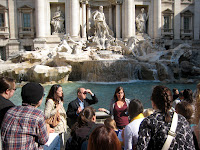





Week three was full of new content and new sites. On Monday we met in the classroom to discuss the transformation of the altarpiece. We centered our discussion around Raphael and Sansovino’s Saint Anne altarpiece in Sant’ Agostino. After establishing some context for the readings, we traveled to Sant’ Agostino together to view the work, as we so often now get to do, in person.
On Tuesday we met in the field in front of the Pantheon. Our nine o’clock meeting time granted us about thirty minutes of precious quiet with the ancient monument, before the throngs of tourists arrived. Rachel gave her site presentation, leading us in a discussion in the possible numerical interpretations of the architectural elements of the Pantheon.
We narrowly escaped the formidable crowd, hungry for photos of the dome and oculus. We slipped past them up Via della Scrofa to the Ara Pacis for our next site visit. Augustus’s Ara Pacis (altar of peace) had been under restoration for many years while a new building was constructed for the monument. The Richard Meier museum looks like a fairly standard modern building from the outside, but the white interior and ubiquitous windows create a beautiful viewing environment for the ancient object. Shannon led us in a discussion of the scholarly approaches to the Ara Pacis. We considered its iconography as well as its function as an object of ritual worship.
On Wednesday we met in the classroom initially to begin our discussion of Michelangelo’s Last Judgment. We dealt with the reception of the fresco within the changing climate of religious reform in the early to mid sixteenth-century. To continue this thread we packed our bags and walked up the street, once again, to Santa Maria sopra Minerva for a discussion of Michelangelo’s Risen Christ. Ryan led us in considering the possible viewpoints of this highly criticized sculpture. As it is not in its original position, we attempted to reconstruct the period-viewer’s experience of the work.
On Thursday our professors arranged for us a special treat – but it meant an early meeting time. At eight o’clock we gathered in front of the Rome Center to meet Bill Guillon, a local chef who had agreed to take us on a market tour of the Campo de’ Fiori. We learned where to buy fish, meat, eggs, milk, cheese, groceries and vegetables, all within a short walk from our school.
After our market tour, we fueled up on cappuccini and caught a bus taking us well outside the city walls to Santa Costanza and Sant’ Agnese Fuori le Mura. This day marked our transition in Art H 397 from ancient material to early Christian. At Santa Costanza we analyzed the fourth century mosaics, replete with potentially Dionysian imagery. At Sant’ Agnese, we were able to consider the transition of the Roman meeting house – the basilica – into the basic architectural plan of the early Christian church.
On Thursday night, our week of hard work was rewarded. We met at the Mamelli apartment and Bill the Chef rejoined us for a cooking lesson. We learned to make Penne all’Arrabbiata, pork roasted with balsamic vinegar and panna cotta. It was delicious. I think we all thoroughly enjoyed ourselves and we had the chance to properly celebrate Dabney’s birthday. Buon compleanno!




 lpture and architecture. Our reading on the work prompted us to consider Bernini's influence over the commission and the execution. We thought about the effect this breaking of space would have had on the seventeenth century viewer and we discussed the motivations for the Jesuits to utilize such visually powerful decoration in their primary church.
lpture and architecture. Our reading on the work prompted us to consider Bernini's influence over the commission and the execution. We thought about the effect this breaking of space would have had on the seventeenth century viewer and we discussed the motivations for the Jesuits to utilize such visually powerful decoration in their primary church. 






























